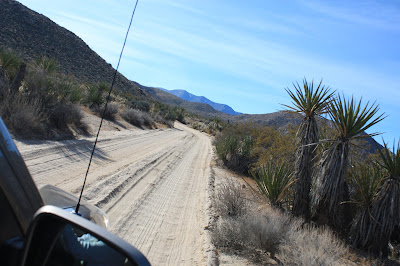After some difficulty, we located an unmarked dirt road leading off into the desert. A few small signs soon let us know we were on the right course.
After driving several miles on the sandy, rutted road, we found the trail head leading to pictographs made by the Kumeyaay tribe around 2,000 years ago.
Along the way was this interesting boulder that reminded us of a cyclops head.
After a mile, we reached the pictographs, on the face of an inward sloping boulder.
Little is known about the meaning of the symbols which were made with natural dyes. It is thought that shamans performed spiritual ceremonies having to do with adolescent rites, solstice rituals, and vision quests. Considering their age, it is amazing these pictographs haven't been destroyed by weather or vandals.
There are about 50 pictograph sites that have been found in the Anza Borrego Desert, our largest state park.
Near the the base of the boulder was this mortero made by the Kumeyaay to grind mesquite beans and pinon nuts.
As we hiked on, we notice junipers on the rocky cliffs.
The desert wash narrowed to the top of a dry waterfall where we had our lunch and enjoyed the desert views below.
Lookout! I might be a stinkbug.
This dead agave had a nest hole in its stalk.
The dangerous cholla cactus was scattered most everywhere.
It was a beautiful January day in the low 70's.
This gnarled juniper was doing its best bristle cone pine imitation.
The desert beauty is subtle this time of year.
A small fishhook barrel cactus.
We hiked back to Dusty, our car, and drove to the next trail head which led to the site of a seasonal Kumeyaay village. We saw several boulders that had small divots ground into them near larger morteros. We aren't sure of their cause or purpose.
There were many morteros in an area of about a hundred yards.
One mortero still had well preserved fingers lying in it.
At first I thought that the Kuyemaay women ground this mortero clear through the bottom of the boulder, which must have been thinner than they expected. I have since read that the hole may have had a purpose. A heavy wooden pestle can crack mesquite seeds and the hole would sift out most of the debris - a modern day equivalent is the hammermill.
Near the center of the village site was this dramatic boulder. There were more morteros on the side that provided afternoon shade.
Drying cholla blooms. In a good rainfall year, the desert can be swathed by dazzling flower displays. Will this be such a year?
Well, it was off to our last destination, the famous Ghost Mountain experiment.
On the way, we passed this large barrel cactus. This could be well over a hundred years old!
We hiked a mile up a steep trail to the top of Ghost Mountain to examine the remains of a most remarkable family home site. In 1932, the artist and writer Marshall South and his wife Tanya built a home on the top of the mountain, in the middle of the desert, which was basically on a mountain size pile of boulders.
They built their home out of adobe, lived off the land, and raised three children. The biggest remains are of the water collection system.
An old baby buggy (?) wheel adorns a crumbling adobe wall.
This is the site on the mountaintop where they lived for 16 years until the military decided to make a bombing range out of the mountain towards the end of WWII. This, and the fact that Marshall was having a torrid affair with a woman up in Julian, caused the family to split up. Marshall wrote monthly articles for magazines, mainly Desert Magazine, throughout this experiment in living. A big goal was to raise the children to be free thinkers. Marshall was quite a sight when leaving the mountain for supplies, wearing only a loin cloth, home made sandals, and hair down his back. The family is considered to be the original hippies. We are trying to locate a copy of a documentary released in 2007 about the South Family.
Views from the home are still awesome!
Heading back down the mountain trail, you can see Dusty waiting (slightly right of center). Recently, I heard on KNPR that driver-less cars are being tested on public roads. This got me wondering, what if Dusty got mad about being left in the hot sun or something, said, "Screw this!" and decided to take off on his own? We can't let this happen, folks! Say "NO" to driver-less vehicles!
Driving back to the highway, we noticed strange orbs growing on a dry lake-bed. It turned out they were feral squash! How they survived there is beyond us. The drive home was interrupted by the mandatory stop in Julian to bring home a fresh apple pie, and then pizza and beer outside of Julian at Wynola Pizza and Bistro - highly recommended! And so ended another fine day.































2 comments:
What an informative blog you presented. I know so much more about morteros than I ever did before!!! Wow!
Well, I agree with "Bob" -- this is fascinating. The picture of the fingers coming up through the morters is pretty eerie. Are those THE FINGERS OF "BOB?"
Post a Comment